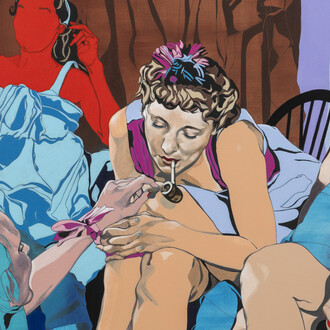The Stedelijk presents the first major retrospective of Karel Martens (1939), one of the Netherlands’ most influential post-war graphic designers, renowned for his inventiveness, and for his playful and experimental approach. Karel Martens trained and inspired younger generations of designers in the Netherlands and internationally. The exhibition is a journey of discovery through the oeuvre that Martens created over 65 years—from his adventurous lettering on buildings, to books, typography, postage stamps, telephone cards, and wallpaper.
Internationally, Dutch graphic design has traditionally enjoyed a strong reputation. Building on the modernist tradition of predecessors such as Piet Zwart, H.W. Werkman and Willem Sandberg, Wim Crouwel, Jan van Toorn and Karel Martens were the Big Three in the world of graphic design from the 1960s onwards. Where Wim Crouwel was known for his functional grid, that served to highlight content, and Jan van Toorn brought his activist and personal side to the fore, Karel Martens—as an experimental, curious and free maker—also revolutionized the way we look at graphic design, book design, and typography.
For Karel Martens, it’s all about thinking, looking, and experimenting. “I love playing about, trying things out, not being quite sure, starting over.” Martens plays with color systems, numbers, word schemes, and algorithms, where one element arises from another. He frequently layers bright areas of color over one another and uses both digital and analog techniques.
Martens is also resourceful, able to do a lot with very little; his inventiveness and economy are apparent in his work. Keen to avoid waste, he repurposes newsprint, and the Stedelijk’s old archive cards. He doesn’t hesitate to stray from design ‘rules’: a text can start on the cover or be found in the margins. The architecture magazine OASE exemplifies his most ambitious experiments; no two issues are the same. Martens began designing OASE in collaboration with students from the Werkplaats Typografie, which he co-founded; today, he designs it with his daughter, Aagje Martens.
Since Karel Martens began collaborating with his children Klaartje and Diederik in 2019 under the name Martens & Martens, the scope of his work has broadened to include textiles and collaborations, such as with Suite702, which produces towels based on Martens’ color system for the beach cabins in Le Havre. Martens’ designs have also been incorporated into textile designs for Liberty London, Maharam, Hermès, DUM, Pop Trading Company, and Pentagram, among others.
The table Martens designed for the Werkplaats Typografie in 1998 is now also part of the Functionals Collection.
















